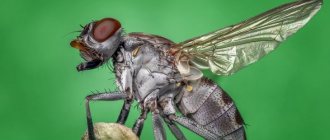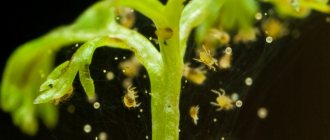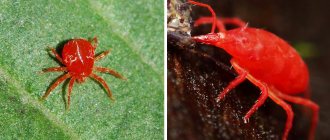09.10.2019
Experienced gardeners and gardeners often encounter an invasion of various pests that destroy plantings and spoil the harvest. Spider mites are a frequent visitor to our gardens and orchards. It attacks a variety of types of plantings - fruit trees and bushes, ornamental crops. The parasite's favorite treat is roses. Not all gardeners pay due attention to this problem when cobwebs appear on rose bushes. But the mite is capable of destroying a large number of pink plantings.
- What is a tick
- Signs of plant damage
- Fighting spider mites on roses
- Prevention measures
Causes of mites on indoor roses
Often, indoor roses are kept in warm and dry climates, mistakenly believing that such conditions are ideal for the plant.
[ads1]Meanwhile, this climate contributes to the appearance and active reproduction of spider mites. And if the necessary measures are not taken in the near future, located next to the affected plant becomes possible
That is, the main reason for indoor rose infection by spider mites is dry air in the room.
The mite can also infect a plant that is not properly cared for: indoor roses in the active growing season especially need moisture. And if the plant is not provided with this moisture, there is a high risk of spider mites appearing.
Who is this?
Spider mites (lat. Tetranychidae) are an animal that belongs to the phylum arthropods, class arachnids, subclass mites. The most famous member of the family is the common spider mite. It is a pest of indoor, garden and agricultural crops. It is found on all continents where there is vegetation, except Antarctica.
How is it different from other types?
The main distinguishing feature of the spider mite is its ability to secrete cobwebs, which is why it got its name. They wrap the plant with this thin veil, in which they then live. This species can also change from green to orange or red. It all depends on what the parasite eats and where it lives.
What are the reasons for the appearance?
Maintaining a collection of indoor flowers at the proper level requires constant replenishment. Infection can occur:
- when purchasing a new copy;
- because of a bouquet of flowers brought;
- during the exchange of sprouts between gardeners;
- when a tick enters a room with the wind through an open window or vent.
There is nothing to be done here, because it is visually difficult to recognize the presence of spider mites on the plant. At first, it may be inactive, being in a state of diapause.
Most often, the pest settles on plants with tender and succulent foliage, in particular indoor roses. And, as a rule, roses are grown in warm and dry conditions, mistakenly believing that this microclimate is as comfortable as possible for the flower. Meanwhile, such parameters are the most successful for the active reproduction of spider mites. And if measures are not taken in time, then in a fairly short time all nearby flowers will be infected.
Attention: the main reason for mite infestation of indoor roses is low air humidity in the room.
A harmful insect can also damage a flower if it is not properly cared for. For example, during the active growing season, a rose requires a sufficient amount of water; if there is not enough water, there is a high risk of being attacked by mites.
Description of the pest
Tetranychidae are omnivorous pests that differ in internal structure from insects. The length of females is on average 0.5 mm, and males are even smaller. Mites have 4 pairs of legs, while sucking insects have 3 pairs. The body is elongated, flat, divided into three sections. It does not have a chitinous cover. The structure of the eyes is simple, there are two pairs of them. The spider mite's mouthparts are sucking.
Ticks live in colonies. One generation of spider mite lives from 12 to 24 days. The female lays over 100 eggs during her life. So in a year animals can leave from 8 to 18 generations. The higher the temperature and the drier the air, the more actively pests develop. Under unfavorable conditions, ticks fall into suspended animation, and in this state they can remain in dry leaves and soil for a long time, without losing their viability.
Read more about diseases and pests of roses in another publication.
What is the danger?
Spider mites cause irreparable damage to the plant, even death. It is placed on the back side of the leaves of a houseplant and the juice is sucked out. Depending on the number of Tetranychidae individuals, one can judge the condition of the indoor rose, but in any case it does not look healthy and blooming.
First, the pest damages the lower parts of the flower, then moves to the outer side of the leaf plate. Then it damages the young shoots. When infested en masse, pests destroy inflorescences and all non-woody parts of the rose.
How is the plant affected?
On an indoor rose, the presence of a spider mite can be recognized by the following external signs:
- sickly appearance of the flower;
- the appearance of white dots on the leaf, which increase in size over time, taking on the appearance of spots;
- the presence of a thin web on the inflorescences and leaves of the rose;
- curling of green leaves, followed by drying out and dying;
- the foliage turns pale, turns yellow, the inflorescences become smaller in size (this and other reasons for the yellowing of rose leaves are discussed in more detail in another article).
Description of the pest
The size of the spider mite is so small that it is quite difficult to detect it on a rose with the naked eye. Upon closer inspection, it will look like a tiny moving grain of sand.
On a note! Moreover, most likely, it will be a female, since males are even smaller!
Spider mites always live in numerous colonies - about a hundred or more individuals. And the main sign of their appearance on the plant will be a very thin web located on the lower surface of the leaf, and under it - small parasites.
If we examine the structure of an adult spider mite at multiple magnification, we will find that its body is oval in shape and has eight walking limbs, while the larvae have only six. The female's body size is about 0.4-0.6 mm, the male's is 0.3-0.4 mm. The integument is soft, the upper part of the body is somewhat convex, the lower part is flat. Individuals arriving at the larval stage of development have transparent integuments, the color of which can range from light green to greenish brown. There are distinct dark spots on the sides. Overwintering female spider mites turn orange-red or bright red at the end of summer and retain this color until the following spring.
Features of life
Quite big difficulties in the fight against spider mites on roses arise at a time when all plants have rich green foliage, since this is the main source of food for these pests. If you do not properly clean the garden in the fall and do not remove fallen leaves, the parasite will settle in for the winter and successfully survive the cold.
On a note! That is why it is necessary to remove and burn leaf litter regularly. This way you can destroy both spider mites and pathogens of various fungal diseases!
With the arrival of spring, the spider mite wakes up, gets out of its hiding place and rushes to succulent young shoots. By summer, the size of the colony increases significantly - the larvae have a huge amount of food for normal development, and the adults actively reproduce. Moreover, the formation of the parasite takes an extremely short period of time - with an abundance of food, in just a week the larva turns into a sexually mature tick.
Chemicals
The most effective are modern chemical preparations aimed at combating spider mites. It is advisable to choose special products, because insecticides developed against insects will not work. Acaricides and insectoacaricides help fight ticks. You can get rid of it completely if you use the drugs several times over a certain period of time. This scheme will allow you to destroy adults and larvae that emerged from eggs after a while. Biological products are better for use because they are less toxic.
The most popular drugs are:
- Neoron. A unique drug that destroys both adults and eggs. Two treatments will be enough. Dilute the contents of the 12.5 ml ampoule in 10 liters of water, mix thoroughly and spray.
- Fitoverm. Biological preparation with a low degree of toxicity. Spraying with Fitoverm should be carried out outdoors or in a well-ventilated area.
- Aktofit. The drug is used in a proportion of 4 ml per 1 liter of water. For spraying, it is better to choose 2 days without precipitation, so that the rain does not wash the solution off the leaves.
- Aktara. Used for most pests, but not for mites. Aktara is diluted at the rate of 8 g per 10 liters of water. Spraying should be repeated after 10-15 days.
- Alatar. The biological product Alatar is diluted at the rate of 5 ml per 10 liters of water. The instructions recommend spraying 1 or 2 times to increase the effect.
- Actellik. Actellik is a toxic insecticide with a pungent odor, so it should not be used indoors. Dilute 1 ml per 1 liter of water. It is more suitable for indoor plants, since the garden requires a large amount of it.
- Anti-mite. An effective remedy against ticks. Anti-mite is diluted at the rate of 1 ml per 1 liter of water. The protection is valid for 25 days. Because of these proportions, it is advantageous to use it not in the garden, but for a small number of plants in a greenhouse or conservatory.
- Karbofos. This is a broad-spectrum drug. Processing is carried out in dry, windless weather. The solution is prepared 75 g per 10 liters of water. Suitable for use in the garden, since 2 liters of solution are required to process 10 bushes. For details on using Karbofos, see the instructions.
Consequences of infection
If you still cannot avoid the damage to your indoor rose by spider mites, it is important to start treating the plant as soon as possible. Otherwise, the consequences of infection can lead to negative consequences:
- The cells of the plant are destroyed, as a result of which it becomes weaker, and the area of its photosynthesis sharply decreases.
- The aesthetic appeal of the rose is lost. Its petals, fresh and green before, begin to turn yellow and dry. The buds become smaller and more inconspicuous.
- Spider mites, in addition to feeding on plant cells, depriving them of vitality, are also carriers of various infections , such as gray rot and others.
Ways to fight
It is worth clarifying that it is difficult to fight mites, since all remedies act on living individuals, but there are still eggs from which new pests regularly appear. It has been noticed that at normal room temperature +24-25°C, generations change after 2-3 weeks, which means that during this time it is necessary to periodically treat the plant, and do this until complete victory. If at least a few living individuals remain, then in just a couple of weeks they will multiply again and spread throughout the entire bush.
To combat ticks, the following drugs are recommended: Actellik, Fitoverm, Fufanon, Neoron, Actofit. These products are toxic, so before using them you need to open the window, take care of rubber gloves and a respirator. Before starting treatment, the plant should be watered well, the leaves and stems should be washed with soapy water (after this procedure there will be fewer parasites), and only then sprayed. It is advisable to alternately use several products to avoid pests becoming accustomed to them.
Among folk remedies there are many recipes that allow you to fight ticks, but, unfortunately, they are effective only at the initial stage of infection:
Folk remedies are safe for plants and the environment, but their effectiveness compared to chemicals is much lower. If there are a lot of insects on the bush, you should not waste precious time - it is better to immediately begin treatment with more serious means, strictly adhering to the recommendations in the instructions.
Prevention
In order to avoid damage to indoor roses by spider mites, it is necessary to provide the plant with proper care.
Since the mite actively reproduces in low humidity conditions, it is necessary to ensure high-quality moisture of all surface parts of the plant.
It is recommended to periodically spray the rose with water at room temperature from a spray bottle. At the same time, you need to make sure that drops of water do not linger for a long time on the leaves and petals of the plant, this can start the process of decay.
It is necessary to promptly remove dried leaves and faded buds from the plant, since the mite can actively develop in them, gradually infecting the entire plant.
Folk remedies
There are a lot of traditional ways to combat ticks. Below are the most effective and easy to prepare.
- A decoction of black henbane. Take 1 kg of dried and chopped henbane leaves and pour 10 liters of boiling water. Let it sit for 12 hours, strain and add 40 g of liquid laundry soap. Soap is added so that the solution lingers on the leaves and does not roll off immediately.
- A decoction of medicinal dandelion. For 10 liters of hot water, take 500 g of fresh leaves or 300 g of dry roots. The broth should stand for a day, after which it must be strained and you can water the plants.
- Decoction of field chamomile. Take 1 kg of dry chamomile per 10 liters of hot water. Let it brew for 12 hours. After this, strain, dilute with water, add 40 g of soap and you can begin processing.
- Garlic solution. Take 30 g of garlic per bucket of water. The solution is infused for about a day in a dark place. You can add laundry soap.
- Onion infusion is also effective in the fight against ticks. Take 200 g of fresh husk and fill it with warm water. The decoction is left for 12 hours, then filtered and used as directed.
- Hot peppers. Take 50 g of red hot pepper per 500 ml of water. Spray the leaves.
- Hydrogen peroxide 3% is used in a proportion of 20 ml per 1 liter of settled water. Hydrogen peroxide works best against mites. Safe for humans, there is no odor and the effect appears immediately.
- You can use a vinegar-based solution. Vinegar is harmful to ticks.
Prevention
Spider mites can enter the house through the wind through a window, with soil in new plants, or hatch from “dormant” eggs when favorable conditions occur.
To prevent the rose from becoming covered with cobwebs, it is necessary to follow preventive measures:
- do not allow the air to dry out. You can regularly spray the plant leaf by layer with settled water;
- periodically treat with biological products;
- do not purchase plants with drooping, pale or damaged leaves;
- Do not place new flowers nearby until they have completed a 2-week quarantine.
To avoid relapses, window sills and windows should be periodically washed with a solution of laundry soap (or any alcohol product); it is also advisable to wash curtains once a quarter.
Useless measures: mosquito fumigators, Pest Reject type repellers, freezing and pouring boiling water over plants (dangerous).
House roses are one of the most commonly attacked plants by spider mites. In the initial stages, a few washes with soapy water and subsequent observation are sufficient. Treatment with a biological or chemical drug is advisable for relapses.
Fighting methods
You can get rid of mites on a rose either with the help of acaricides or by resorting to folk remedies. The choice of drug should always be based on the degree of infestation.
Chemicals
In the fight against spider mites with a large colony population, it is customary to use modern tools, which are acaricides. These products are divided into two groups: specific acaricides and insectoacaricides. The first ones work exclusively against spider mites. Such drugs may have different chemical compositions, but they all exhibit contact activity. The latter destroy both spider mites and other pests living on roses. Let's look at the most popular acaricides in more detail.
"Actellik" is a drug from the organophosphorus group, characterized by intestinal contact action. The active substance is pirimiphosmethyl. Actellik provides reliable protection against parasites for 1-2 weeks. And to achieve a positive result, it is recommended to carry out the treatment twice - the second 7 days after the first. It is not suitable for use in domestic conditions, as it is quite toxic, but in open air it exhibits very good efficiency. To prepare the working solution, you need to dilute the contents of one ampoule (2 ml) in a liter of water
The prepared preparation is sprayed on the above-ground parts of the affected plants, paying special attention to the lower surface of the leaves. "Apollo" - destroys spider mites when they are in the egg, larvae and nymph phase, sterilizes adult individuals, which is why they lose their ability to reproduce. Its active ingredient is clofentesine
Apollo provides long-term plant protection: from 2 to 3 months. The treatment should also be carried out twice. If necessary, you can additionally use compounds from the same group. To prepare the working fluid, the contents of one ampoule (2 ml) are diluted in five liters of water. "Floromite" - the main active component of this drug is biphenazate. Destroys a pest that is in the active stage of its development, and shows activity quite quickly - a couple of hours after treatment, the parasites lose their ability to damage plants. Maximum effectiveness is observed after 3-4 days and lasts about three weeks. Spraying is carried out twice at weekly intervals. The working solution is prepared from 2 ml of the product diluted in five liters of water.
However, it should be remembered that frequent use of broad-spectrum drugs can worsen the situation. This is due to the fact that such products destroy other insects, including those that are the natural enemies of spider mites. In addition, when roses are repeatedly sprayed with insecticides based on pyrethrins and phosphates, the concentration of nitrogen on the surface of the leaves increases, which is only beneficial for this pest.
Folk remedies
Sometimes it is possible to get rid of mites on a rose using folk recipes, which can be based on essential oils and alkaloids, as well as other natural compounds. Treatment with such solutions must be carried out at least three times with an interval of five to seven days.
Garlic infusion. To prepare it, you need to chop half a kilo of garlic and add three liters of water. After 5 days of infusion in a warm place, the product is filtered and diluted with water - 55-60 ml of the drug per 10 liters of water. Add 50 g of laundry soap to the prepared solution and use it to spray plants and soil. Infusion of black henbane. Grind a kilo of dry raw materials and pour in 10 liters of water. Leave in a warm place for 12 hours, then filter and add 40-45 g of laundry soap. We carefully treat the infected rose bushes with the finished product. A soap solution works well against spider mites. Crushed laundry soap is diluted in water to create a lot of foam, and the leaves and stems are treated with the prepared solution. It is better to wipe the plant with a soft sponge.
As for tillage, it is very important to observe moderation - you need to spray the soil carefully, literally a few drops. Otherwise, the root system will be damaged, and the roses will simply dry out after a week.
Treatment of indoor rose
Signs of defeat
Before starting treatment, you need to make sure that the cause of the plant’s illness was the spider mite.
Here are the main signs of the presence of this parasite:
- The plant is covered with cobwebs.
- Light dots and spots are visible on the outside of the rose leaves.
- The leaves of the plant dry out and fall off.
- Small moving dots can be seen on the inside of the sheet. These are ticks.
Pest control
Measures to eliminate spider mites must be comprehensive. It is good to use folk remedies in combination with chemicals.
Basic tips for pest control:
- First of all, the affected plant must be thoroughly washed with soapy water. This will significantly reduce the number of parasites.
- The plant is watered abundantly with cold water.
- Rose leaves are treated with a decoction of onion peels or dandelion (the procedure is carried out once every 4-5 days).
- You can use a diluted infusion of garlic. 170 gr. garlic, minced in a meat grinder, pour a liter of water, leave for 5 days. The resulting infusion is diluted with water and the leaves of the plant are sprayed with this solution.
- If the plant is very heavily infected, it is recommended to use chemicals to combat mites (Aktellik, Neoron). These products are quite toxic, therefore, when using them, it is necessary to protect your hands and ensure a flow of fresh air in a closed room. The advantage of these drugs is their effectiveness; it is enough to use the product 1-2 times, and the problem of spider mites will be resolved.
Video recommendations
The video below should help you cure your plants from this unpleasant disease; it will talk about general methods of control and prevention of domestic roses, and the drug “Actellik” will be considered as the main “weapon”.
It is known that preventing infection is much easier than treating it later. That is why provide your plant with proper care, and it will never cease to delight you with its beautiful appearance.
Loading…
News from partners:
Folk recipes
They should be used when the infection is only in the early stages or when the rose is very young.
- Soap solution - Any soap from ordinary liquid to tar is dissolved in a container of water. The main thing is to have as much foam as possible. Then manually wipe each leaf and stem with a sponge dipped in a soap solution. Only the soil must be covered with plastic film in advance. After a few hours, wash off all this solution from the leaves with an ordinary damp sponge and immediately cover the rose with plastic wrap. Leave it like this for several hours. Parasites should die completely in conditions of high humidity.
- Garlic - 50 grams of grated garlic is diluted in a three-liter jar of boiling water, placed in a dark and dry place for five days. Strain and thoroughly spray the entire bush.
- Onion peels - Collect about 100 grams of onion peels, pour 5 liters of boiling water. Leave in a dark and dry place for about five days. Strain and spray the entire bush. This remedy may not work if the flower is severely damaged.
- Ammonia - A standard 30 gram bottle of ammonia is diluted in a ten-liter bucket. Using a sponge or cotton pad soaked in it, treat each area of the damaged plant. You can water the soil with a small amount of this solution.
- Tobacco powder - 500 grams of tobacco powder are diluted in a bucket of liquid. Leave to infuse for a day. After filtering, all plants are sprayed with it every week until the mites completely disappear.
- Yarrow - Fill a container with 1 kg of dry leaves of this herb, fill it to the top with boiling water. After four days, strain and process the roses every week.
- Dandelion - Before spraying, 40 grams of medicinal dandelion are infused in a two-liter jar of warm water for about 6 hours.
Prevention
Preventing the appearance of spider mites on roses is much easier than dealing with their invasion afterwards. Preventive measures are extremely simple:
- regularly check the lower surface of the leaves and, before using any drugs, make sure that you are dealing with spider mites;
- each new specimen should remain in quarantine for a couple of weeks - away from your greenhouse, and only after that, if no signs of infection are found on the flower, it can be placed next to other plants;
- try to maintain optimal soil and air humidity - such conditions are unattractive for spider mites, and even if several pests do appear, the humidity will prevent their active reproduction;
- in addition to roses, spider mites are very fond of orchids, and this circumstance must be taken into account when arranging plants;
- remove fallen leaves in a timely manner and do not allow them to accumulate under the bushes;
- for preventative purposes, it is good to use the same soap solution, only in this case they should regularly wipe the window sills and shelves on which the plants are located, as well as the trays and the pots themselves.
By following all the rules described above, you can protect your roses from spider mite infection and enjoy the healthy appearance of your charming “pets” every day.
Signs of plant damage
The spider mite has a peculiar proboscis, with which it attaches itself to the leaves of plants and sucks out their juice. It is the juice that is the main food of parasites. Moreover, any plant, not just roses, can serve as a food source.
Affected leaves
The saliva of mites contains a special enzyme, which, when it gets on the leaves, promotes the destruction of chlorophyll and impedes photosynthesis. The leaves become covered with white spots, turn yellow and fall off. Infected bushes, deprived of sap, weaken, shoots develop poorly, inflorescences lag behind in development, become weak, and in general the entire bush looks small, undeveloped and sick. The weakening of the culture contributes to infection with various infections and diseases.
As a rule, the beginning of the spread of the mite goes unnoticed; not all gardeners pay attention to single changes in the leaves. When the colony grows greatly, the appearance of arthropods becomes noticeable - the bushes and buds seem to be entangled in a web, and numerous colonies themselves can already be seen on the stems.
Mite on a rose
If the problem has reached such proportions, it is necessary to immediately take measures to destroy the mites in order to prevent their further spread not only to roses, but also to other plants, which can lead to loss of harvest.
Inadequate care of flowers and other plants is a factor contributing to the proliferation of mites. Abundant and timely watering will create unsuitable conditions for the pest.
Reviews about spider mite infestation
I learned from my own experience how quickly flowers can die because of this parasite. I couldn't save a few. After that I use Fitoverm.
Grade:
Olga
Terrible pest! He doesn't have enough cucumbers at the dacha. So he also occupied my ficus. They sprayed Apollo at the dacha and sprayed the rest at home, as the article says. It seemed to work.
Grade:
Elena
The battle in the apartment is the second year. A very powerful parasite. We fight with chemicals, wipe, bathe the flowers. It's no use, many flowers died.
Grade:
Michael
I really love indoor roses. Looks like I'm not the only one. Spider mites are crazy about her. Fitoverm helped me save the flower. Processed it twice. True, I added a little detergent. (A few drops). I haven't noticed any ticks yet. It probably helped.
Grade:
Anna
I bought Neoron. I diluted it in water, everything was as written in the article. I treated it generously and tried to spray it everywhere. It helped, otherwise I thought all the flowers would die.
Grade:
Lisa
Spider mites are a dangerous enemy that can be defeated. Its timely detection will help to do this faster. Then it will be possible to keep the indoor rose intact and prevent infection of other plants.
Note! To defeat the pest, you can choose various means - both chemical and folk. But in case of extensive infection, it is better to combine them. And in order to minimize the “capture” of a home beauty by harmful arachnids, it is necessary to carry out disease prevention in a timely manner.
Chemicals
Although they work better than folk remedies, not all chemicals can kill pests the first time. Often only the adult insects are destroyed, leaving the larvae or eggs undamaged.
The tick quickly adapts to some drugs, so they have to be alternated. This is the only way to get rid of the spider insect forever. Only after each treatment, two days later, it is recommended to spray with Epin, which will help the flower continue to grow successfully.
- Fitoverm is one of the most effective biological preparations that will help free all roses from sucking parasites in a short time. It copes equally with both adults and larvae. They are sprayed with it every week until not a single parasite remains.
- Fufanol, Anti-Mite - They do a good job, but parasites get used to them quite quickly, so they are used only once.
- Neoron - It kills not only adult insects, but also eggs, which not every drug can destroy. It is enough to treat the rose twice with an interval of a month with this product.
- Actellik - It is used only in the most advanced cases or after no other remedy has been able to help. When working with it, you need to remove pets and small children from the room so that they do not get poisoned by it. The treatment is done on the balcony or with the windows open. The grower must wear a protective mask, gloves and goggles. The parasite can adapt even to such a strong substance, so it is used no more than twice a year. Although he usually gets it right the first time.
Additional events
You should always monitor the condition of the flowers and take immediate action at the slightest sign of infection. If a parasite is noticed on a plant, it is necessary to rinse it with warm running water, and then wipe the leaves with a low concentration alcohol solution.
Next, you need to choose the most suitable product and treat the rose. Remember that you will also need to treat the window sill and the area where the flowerpots are located. The procedure must be repeated after a week. In order to protect the rose, fertilizer with potassium is applied after the repeated procedure.
How can an insect harm flowers?
The insect is small in size, no more than 0.5 mm, so it is quite difficult to see this parasite. Despite its small size, the pest poses a mortal threat to shrubs. It feeds on plant cells of the crop, damaging its integrity.
Crafts from sticks: instructions, tips and master classes on how to make stylish toys and decorations with your own hands (75 photos and videos)
These parasites infect the leaf blades, and small spots appear on the plant, but if these symptoms are overlooked, the entire foliage of the crop will be covered with cobwebs.










